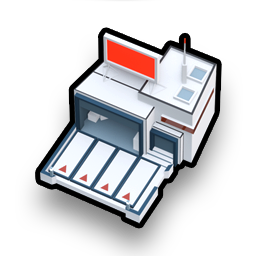Cities
Cities are one of the main elements of progression. Players have 3 cities that can grow if their supply demands are met, increasing their population, the number of tiles they cover, and how advanced the structures within the city look visually.
If a city's supply and waste disposal needs are both at 100%, the city will steadily grow in population. If these needs are at or below 50%, the city will decrease in population. Otherwise the city population will remain the same. If tiles of the city are destroyed by bulldozing, building over them, or floods, the city's population will also decrease.
Supply Center
Each city demands an annual amount of resources. The type and quantity of each resource depends on the city's population. The city can be supplied by delivering resources to one or more Supply Centers placed adjacent to a city tile. Depots must be nearby to move the resources into the Supply Center.
Multiple Supply Centers can be attached to a city in order to split the load between them. The annual supply demand is shared within a city, and so long as it's being met, it doesn't matter which Supply Center is getting which resources.
Formula
City population is broken into 6 tiers. At each tier, the required resources change, as does the rate at which they are consumed. A "tick" of the Supply Center consuming resources is based on the tier, and the minimum and maximum population of that tier. See the following formula and table for more details:
Seconds per tick =
- duration_initial
- Initial tick duration for the current tier
- np_pop
- Current population of the city
- nb_pop_initial
- Minimum population of the current tier
Note: that one year in the simulation is 300 seconds.
| Population | Resources | Seconds per tick | Annual demand |
|---|---|---|---|
| 1 - 9 | Concrete | 60 => 12 | 10 - 24 |
| 10 - 99 | Concrete, Oxygen | 45 => 9 | 10 - 33 |
| 100 - 999 | Reinforced Concrete, Oxygen | 20 => 4 | 15 - 74 |
| 1,000 - 9,999 | Reinforced Concrete, Oxygen, High-tech Parts | 8 => 1.6 | 37 - 187 |
| 10,000 - 99,999 | Reinforced Concrete, Oxygen, High-tech Parts, Food | 3 => 0.6 | 100 - 500 |
| 100,000+ | Composite, Oxygen, High-tech Parts, Food | 1.5 => 0.3 | 200 - |
Waste Disposal
After a city reaches 1,000 population, it will produce waste. This waste can be collected by building one or more Waste Disposals adjacent to a city tile. Depots must be nearby to move the resources out of the disposal. Initially they will produce Metal Waste, but after reaching 10,000 population they will additionally produce Organic Waste, and at 100,000 population they will produce Plastic Waste. These wastes can be processed at a Recycling Center to turn them into usable resources.
Waste production follows the same formula as resource consumption (see #Supply Center above for more information).
| Population | Resources | Seconds per tick | Annual demand |
|---|---|---|---|
| 1,000 - 9,999 | Metal Waste | 5.33 => 1 | 56 - 281 |
| 10,000 - 99,999 | Metal Waste, Organic Waste | 2 => 0.4 | 150 - 750 |
| 100,000+ | Metal Waste, Organic Waste, Plastic Waste | 1 => 0.2 | 300 - |
Recycling Center
The Recycling Center processes waste and turns it into usable resources. Note that while the Waste Disposal must be adjacent to the city, the Recycling Center does not, and so waste can be transported away from the city for processing elsewhere.














